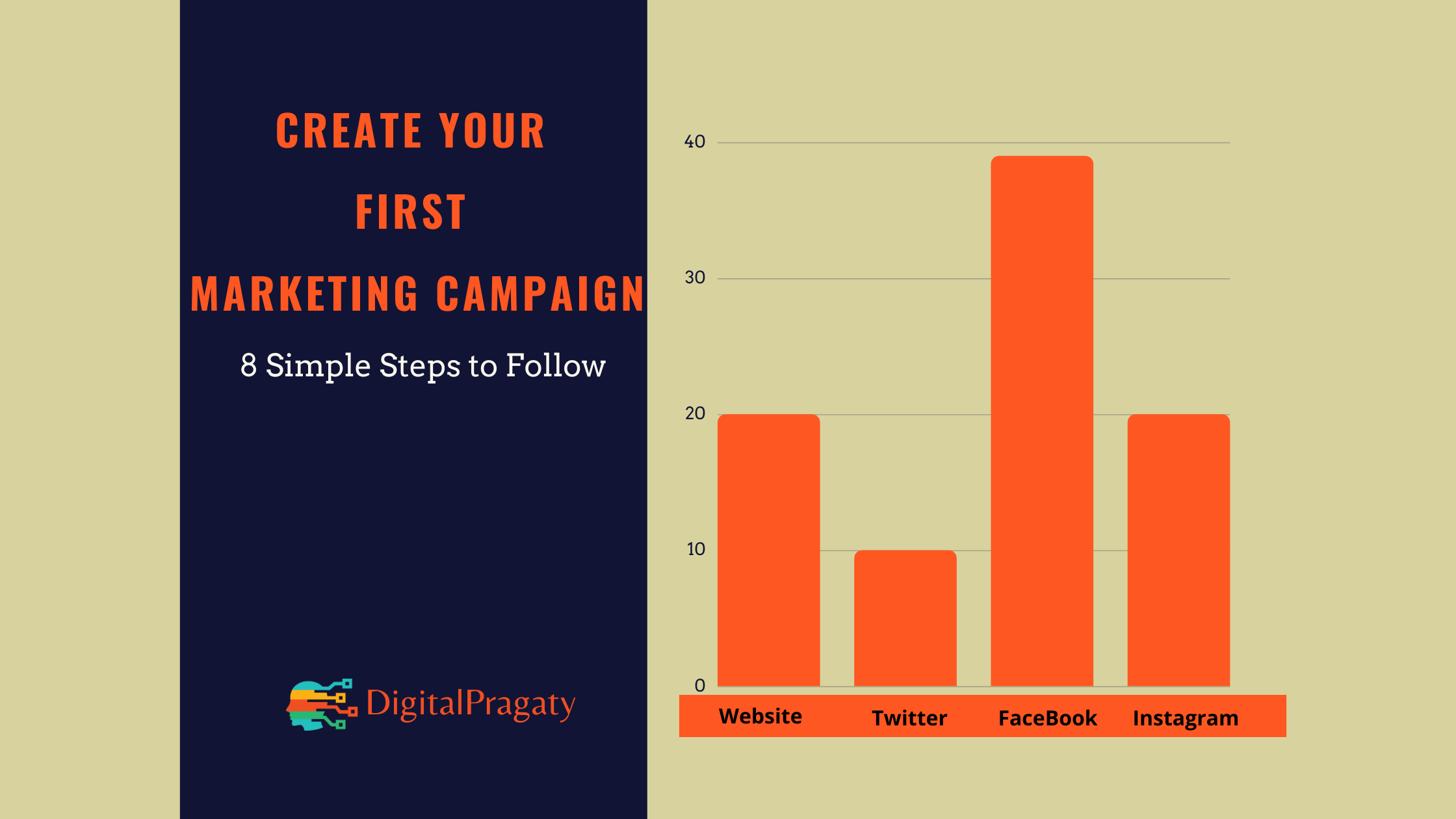
Create Your First Marketing Campaign – 8 Simple Steps to Follow
Before we proceed to create the first marketing campaign, let’s discuss what a campaign is?
“A campaign is basically a series of operations which is designed to bring out a specific goal”.
The purpose of a campaign is an organized effort, which seeks to influence the decision making progress within a specific group.
A successful campaign needs a lot of patience, time, and the most important – planning. If you’ve never run a campaign before, you will find it tough to understand each and every step. Either you had a crash course earlier or you should have knowledge of creating a campaign but don’t you worry about it as in this blog, we will share you the best way to create your first ever digital marketing campaign a success.
1. Summarize Your Individual/Company’s Marketing Goals:

Before you design any campaign, you have to comprehend and layout your overall marketing objectives. Set up SMART objectives for the best outcomes. When we are talking about SMART, it means Specific, Measurable, Attainable, Realistic, and Timely. Your objective may be to achieve a minimum of 10 new customers per month or to sell 10 items every week, or to build your individual salary by 30 percent this year.
2. Decide Your Budget:

Before you begin with research, you’ll need to decide on a budget. Why? Since persona research frequently costs cash, you’ll need to incorporate these expenses as a feature of your campaign budgeting plan. Deciding how much money you can spend at the early stage in the campaign planning procedure will assist you in deciding your objectives, system, and even how much content you can create.
Marketing Budget Categories:
- Website
- Online Advertising
- Email Marketing
- Social Media
- Direct Mail
- Print Advertising
- Public Relation
- Event Marketing
- Television or Radio Advertisements
3. Do a Market Research:

Reveal your services or products along with the benefits and features in detail, just as how it’s unique if compared with the product or service that your opponent is offering. Concentrate on the entirety of the key highlights for your product(s)/service(s), including estimating, service, dissemination, and placement. Collect, sort out, and keep track of this data for future purposes.
Some of the areas that need to be considered are:
- Product – what’s currently available, what your competitors are selling, or check the trending product
- Benchmarks in the industry
- Market dynamics, patterns such as seasonality
- Potential vendors and partners that you will need to rely on
With this progression, you likewise need to think about your opposition and build up your “Unique Selling Price” (USP). What makes you unique in relation to your rivals?

Compose a couple of sentences that state:
- Who your key market is
- What you’re selling
- Your USP
These inquiries and activities will assist you with deciding your objective market and how you can most adequately sell your product or offer your services.
4. Decide your audience: Despite the fact that determining your target audience is repeatedly a measurement of the market research method, it’s vital enough to earn its own step.

Before creating the audience, you must ask yourself: “Who are your target customers? What are their motivations? How do they like being communicated? Which channels are they using? [And] if they’re using social media, what are they talking about? Which media or journal do they read and which sites do they visit regularly? All these issues need to be taken care of before creating your integrated marketing strategy.”
5. How to build your Market Persona:
- First, portray your optimal objective client as far as age, gender, family profession, income, different preferences, lifestyle, buying designs, purchasing products, interests, and many more.
- Test your targeted audience assumptions. You may not generally be offering to who you think you are, or you may not be arriving at your maximum capacity with this intended interest group. Do this through face to face or online groups (in case you have financial planning), client reviews, target by creating quizzes on social media platforms like Facebook or Instagram or Twitter, or utilize social media listening or paid external surveys to receive your data. Who is reacting to your services or products most excitedly? That is your genuine target market.
6. Outline your Campaign Goals:

Before you set up the outline for your campaign, first create the strategy as a position in marketing is important for small businesses. When you’ve decided how you’ll sell your product and who you’ll offer it to, you can begin to layout your particular campaign objectives. You will likewise choose whether your attention is on making brand awareness, client retention, acquisition or maintenance, and development. Keep these objectives attached to measurable KPIs.
Since you as of now have a financial plan as a top priority for your campaign, you can attach a considerable lot of your objectives to a monetary value. For instance, maybe you need to spend $1,000 on Facebook advertisements and get X measure of perspectives and Y measure of new clients. When you get to the campaign analytics, you can undoubtedly decide your campaign’s ROI and check whether you’ve accomplished your objectives or if you have missed it.

At long last, during this progression, you’ll need to choose what sorts of content you need to be a piece of your campaign. You may decide to utilize a portion of the strategies beneath to accomplish your objectives, however, whatever you do, and make certain to think about your personas’ first choice. Do they like to read or they like to watch videos? Do they react well to ads or they simply ignore them? For the best outcomes, make content that can be utilized in numerous configurations.
Information to learn about your personas includes:
- Name of the persona
- Job title
- Company size and industry
- Gender
- Salary
- Location
- Age
- Education
- Goals
- What types of content/promotion they like/dislike
- Common objections during the sales processes
A successful campaign frequently incorporates a wide range of arrangements. When you’ve figured out what sorts of content you’ll utilize, decide your essential offer. For instance, saying you need to “increase sales” isn’t sufficient.
Do you need more individuals to purchase dresses from your eCommerce site, or shoes? Make sure that each component of your campaign effort is set up to direct people to your definitive objective, regardless of whether your objective is a site (for buys, reservations, email, newsletter memberships, blog RSS subscription, and so on.) or a social media platform like Facebook, Instagram or Twitter (for engagement),”.

Before you proceed onward to the next stage, ensure you have a marketing calendar set up to delineate when you’ll be initiating the next phase of your campaign.
Your marketing campaign might include below factor:
- PPC
- Social Media
- SEO
- Automation
- Landing pages/ website/ e-commerce pages
- Content
- Events
- Press Releases/PR
- Analytics
- Direct marketing — magazines, print ads, fliers, etc.
- CRM
7. Content Creation: You’ve done your research and had your campaign setup, now you must be ready to create content. Numerous organizations redistribute to independent or freelance content writers or other agencies to do their writing so they can have more opportunity to concentrate on their marketing strategy.

You may decide to do a few or the entirety of the writing part with yourself if you feel good doing as such, deciding to re-appropriate a portion of your plan. Whatever you choose, once more, ensure you remember your personas all through the whole creation process.
8.Promotion and Execution: When you’ve finished your content or article and have received the close down from any third party or internal team, it’s the ideal opportunity for promotion and execution. There are assortments of strategies you can utilize, including a large number of those mentioned above, for example, email, pay-per-click ads, social media, etc and that’s only the tip of the iceberg.

Each and every individual who enters your marketing funnel by means of any feed, be it a telemarketing-calling, website’s landing page, or any other event, can end up being important, even the ones who don’t buy your product(s)/service(s) at that particular time. Be that as it may, only one out of every odd channel will be directly for your business. Ask yourself: What are the channels’ qualities and weaknesses? In what manner will they assist you in achieving your business or marketing goals?



